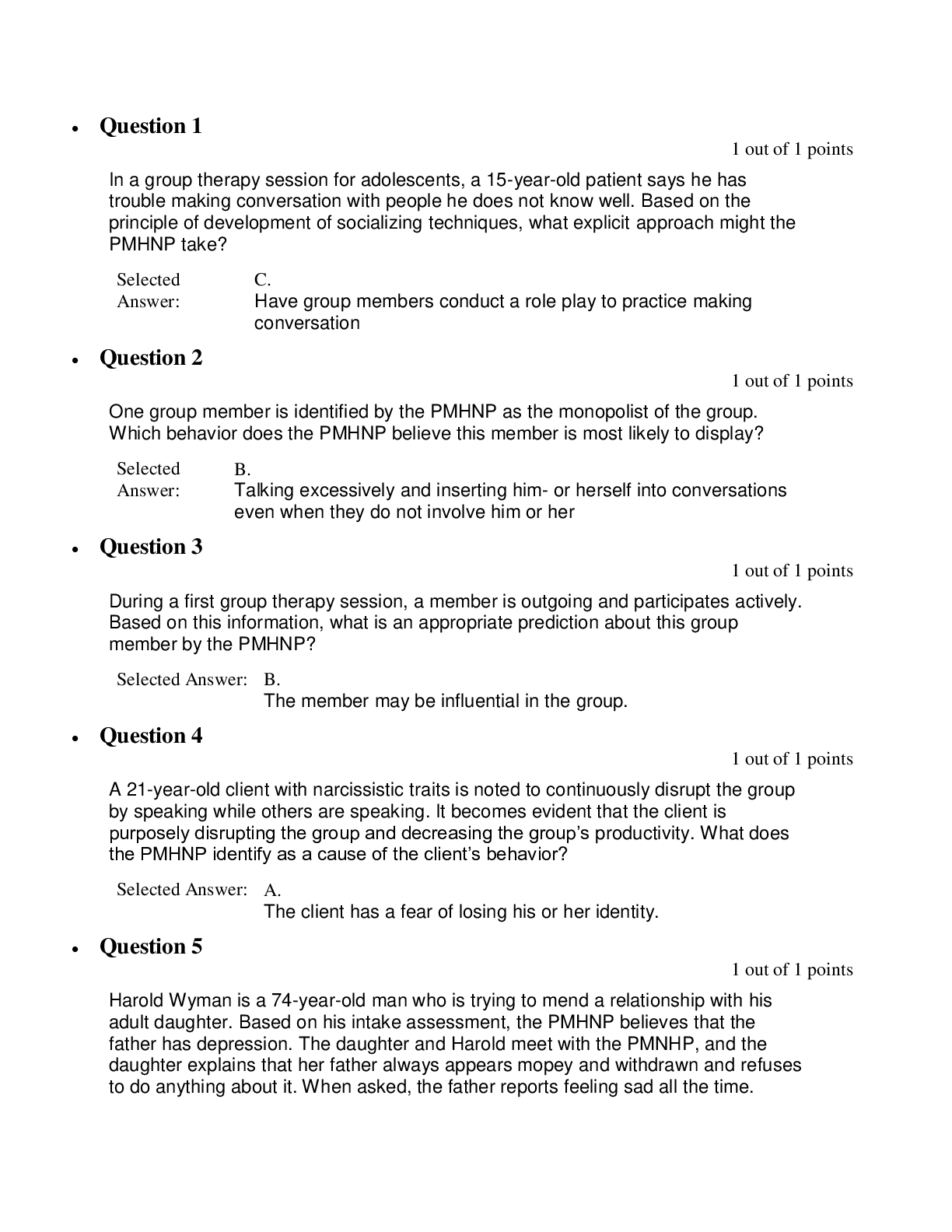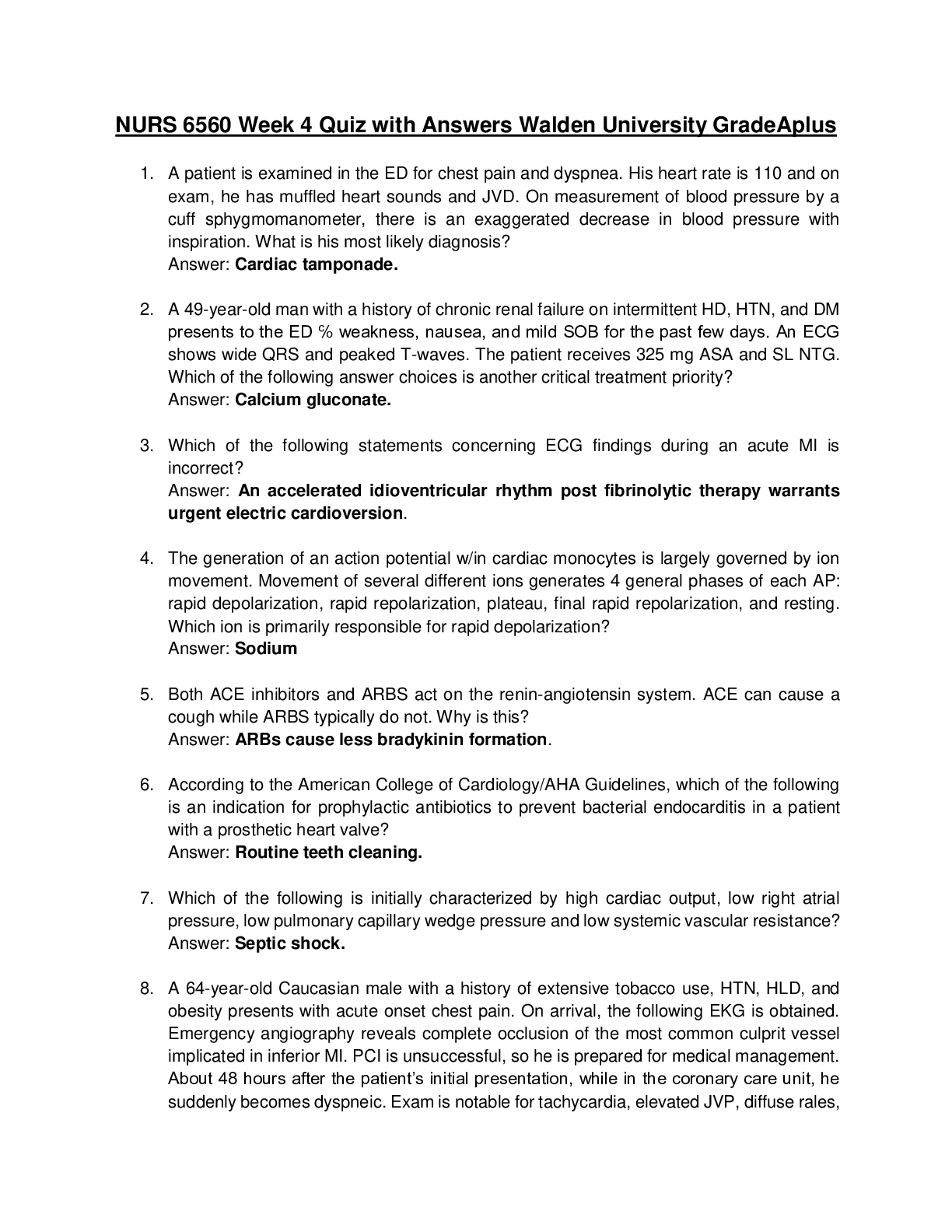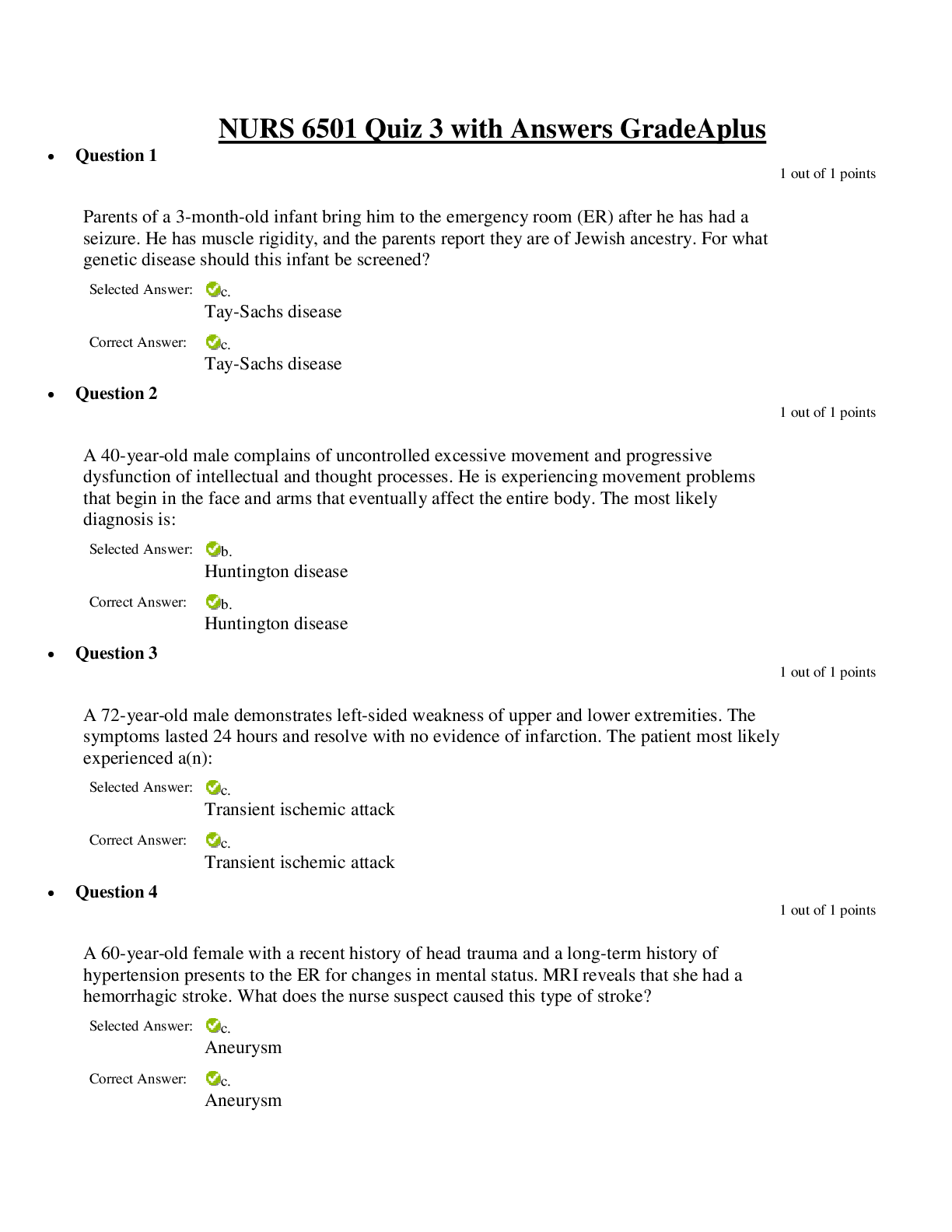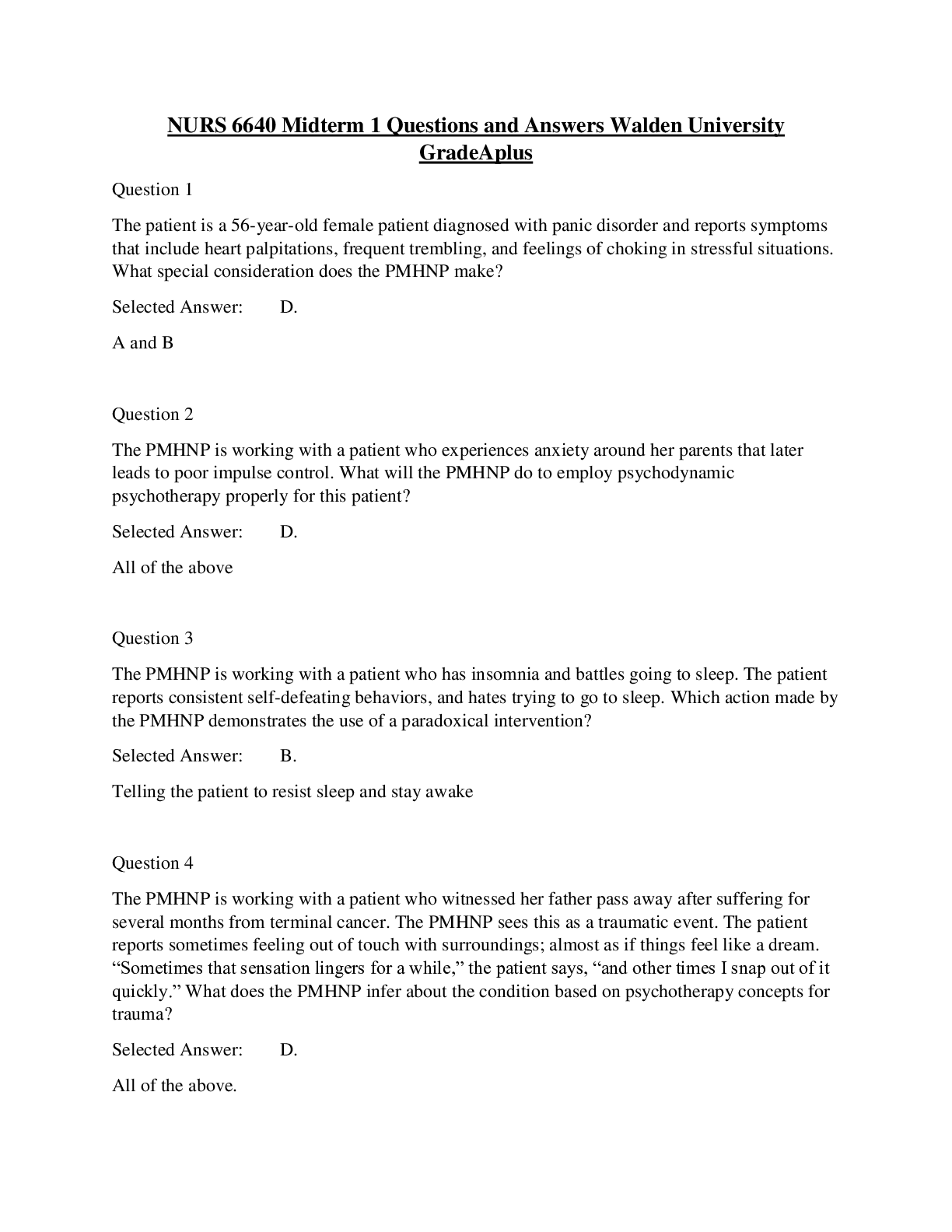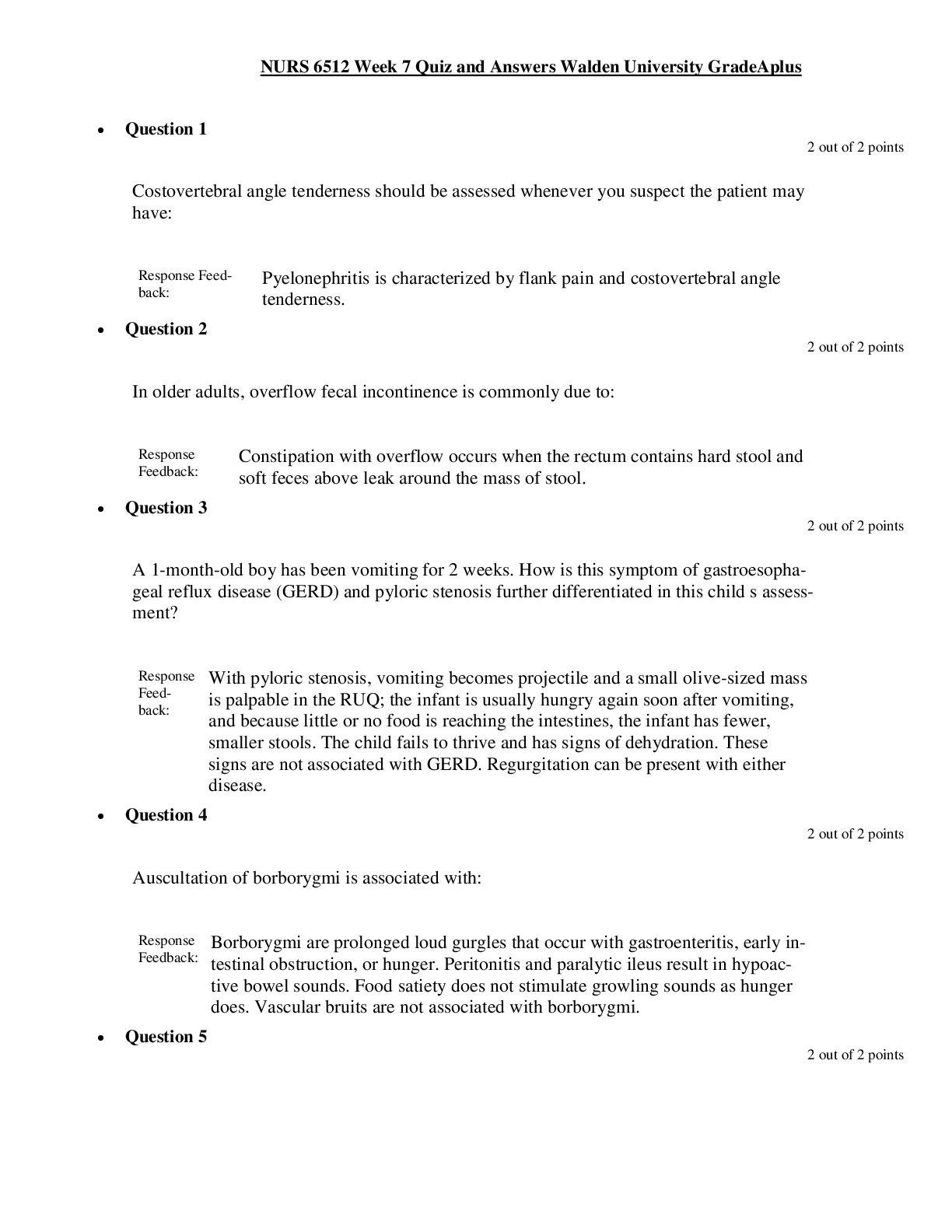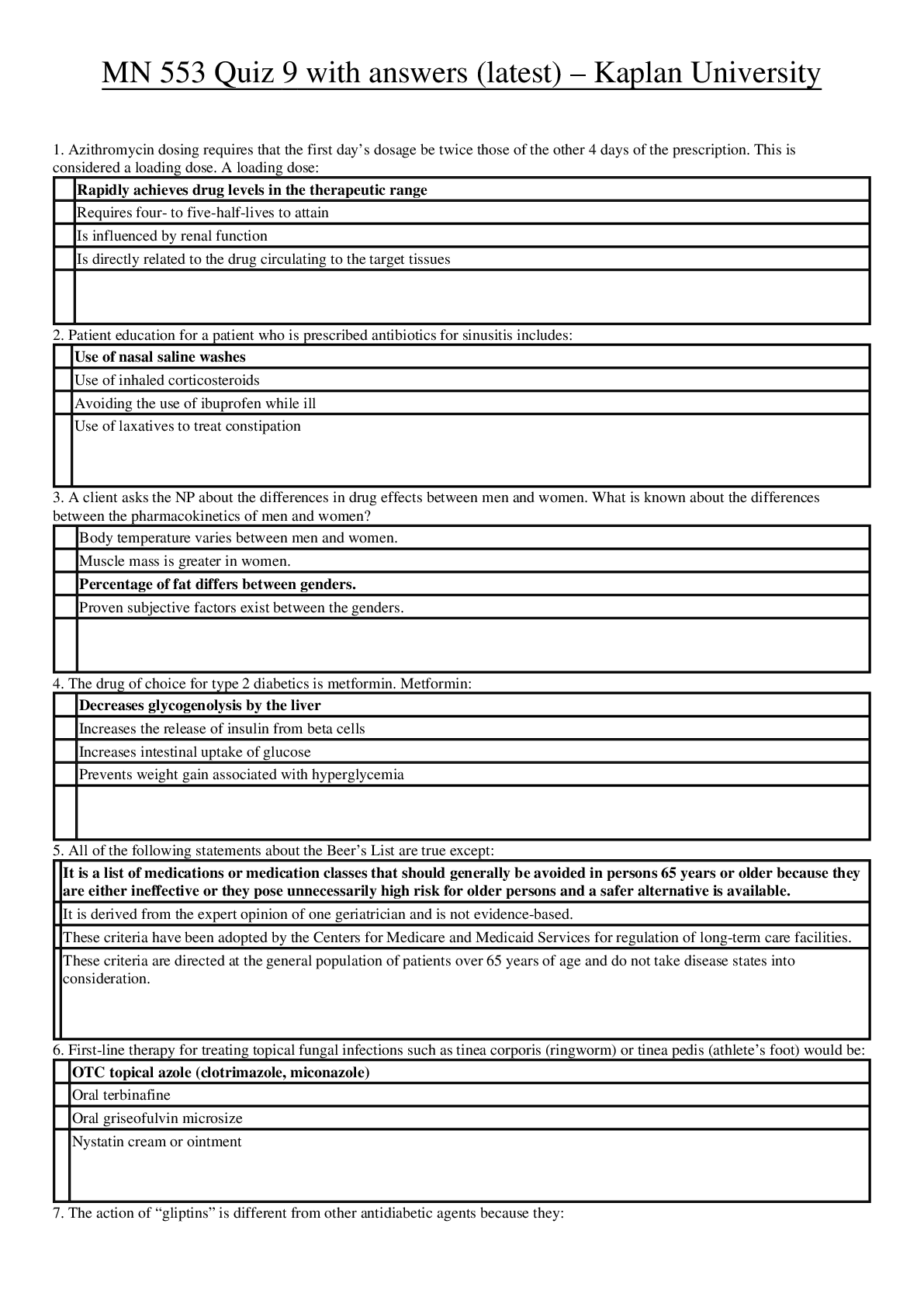*NURSING > EXAM > NURS 6501 Quiz 9 with Answers Walden University (Grade A+plus) | NURS 6501 Quiz 9 with Answers (Grad (All)
NURS 6501 Quiz 9 with Answers Walden University (Grade A+plus) | NURS 6501 Quiz 9 with Answers (Grade A+plus)
Document Content and Description Below
NURS 6501 Quiz 9 with Answers Walden University (Grade A+plus) • Question 1 1 out of 1 points A 40-year-old male undergoes surgery for a PTH-secreting tumor in which the parathyroid is re... moved. Which of the following would the nurse expect following surgery? • Question 2 1 out of 1 points Which principle should the nurse include while planning care for a patient with an ADH problem? ADH release from the posterior pituitary is stimulated by: • Question 3 1 out of 1 points A 30-year-old male presents to his primary care provider reporting visual disturbances. CT reveals a pituitary tumor and lab tests reveal elevated prolactin. He is diagnosed with prolactinoma. Which of the following treatments would the nurse help implement? • Question 4 1 out of 1 points A 39-year-old female just had a baby. Which hormone will prevent excessive uterine bleeding? • Question 5 0 out of 1 points While planning care for a patient from general anesthesia, which principle should the nurse remember? A side effect of some general anesthetic agents is _____ diabetes insipidus. • Question 6 1 out of 1 points When catecholamines are released in a patient, what should the nurse assess for? • Question 7 0 out of 1 points If the patient has a problem with the pineal gland, which substance would the nurse monitor? • Question 8 1 out of 1 points A patient wants to know why ADH is important in the body. What is the nurse’s best response? ADH is important in: • Question 9 1 out of 1 points A 12-year-old male is newly diagnosed with type 1 DM. Which of the following tests should the nurse prepare the patient to best confirm the diagnosis? • Question 10 1 out of 1 points A 35-year-old female with Graves disease is admitted to a medical-surgical unit. While the nurse is reviewing the lab tests, which results would the nurse expect to find? • Question 11 1 out of 1 points A 44-year-old patient with pulmonary tuberculosis (lung infection) is evaluated for SIADH. Which of the following assessment findings would be expected in this patient? • Question 12 1 out of 1 points A 50-year-old female presents with lightheadedness and overall abnormal feelings. Hyperaldosteronism is diagnosed. Which of the following symptoms would the nurse expect? • Question 13 0 out of 1 points Diabetes insipidus, diabetes mellitus (DM), and SIADH share which of the following assessment manifestations? • Question 14 0 out of 1 points A 30-year-old male was diagnosed with hypothyroidism. Synthesis of which of the following would decrease in this patient? • Question 15 1 out of 1 points If a patient’s posterior pituitary is removed, which hormone would the nurse expect to decrease? • Question 16 1 out of 1 points A patient has researched lipid-soluble hormones on the Internet. Which information indicates the patient has a good understanding? Lipid-soluble hormone receptors cross the plasma membrane by: • Question 17 0 out of 1 points A 30-year-old male is diagnosed with a hormone-secreting tumor of the pancreas alpha cells. Which of the following would the nurse expect to be most likely increased in this patient? • Question 18 0 out of 1 points If a patient had a problem with the hypothalamus, which of the following hormones would be affected? • Question 19 1 out of 1 points A nurse is teaching a patient about insulin. Which information should the nurse include? Insulin is primarily regulated by: • Question 20 1 out of 1 points A 3-year-old male was diagnosed with congenital hypothyroidism. The parents ask the nurse if left untreated what will happen. What is the nurse’s best response? If left untreated, the child would have: • Question 21 1 out of 1 points While planning care for a patient with hypothyroidism, which principle should the nurse remember? The basal metabolic rate is unusually _____ with hypothyroidism. • Question 22 1 out of 1 points A 54-year-old patient with pulmonary tuberculosis (lung infection) is evaluated for syndrome of inappropriate ADH secretion (SIADH). Which of the following electrolyte imbalances would be expected in this patient? • Question 23 1 out of 1 points When a nurse is assessing the physical features of individuals with Cushing syndrome, these findings will include: • Question 24 1 out of 1 points A 22-year-old male is admitted to the intensive care unit with a closed head injury sustained in a motorcycle accident. The injury has caused severe damage to the posterior pituitary. Which of the following complications should the nurse anticipate? • Question 25 1 out of 1 points What common neurologic disturbances should the nurse assess for in a patient with a pituitary adenoma? • Question 26 1 out of 1 points A 22-year-old female has a low level of TSH. What condition does the nurse expect the patient is experiencing? • Question 27 1 out of 1 points A student asks the instructor which of the following is the most potent naturally occurring glucocorticoid. How should the instructor respond? • Question 28 1 out of 1 points A 35-year-old female took corticosteroid therapy for several months. Which of the following would the nurse expect to find? • Question 29 0 out of 1 points A 50-year-old male patient is deficient in ADH production. Which of the following assessment findings would the nurse expect to find? • Question 30 1 out of 1 points When insulin binds to its receptors on muscle cells, an increase in glucose uptake by the muscle cells occurs. This is an example of a _____ effect by a hormone. • Question 31 1 out of 1 points A patient wants to know what can cause ACTH to be released. How should the nurse respond? • Question 32 1 out of 1 points A nurse recalls insulin has an effect on which of the following groups of electrolytes? • Question 33 0 out of 1 points A 25-year-old male presents with fatigue, constipation, and sexual dysfunction. Tests reveal all pituitary hormones are normal and no masses are present. The nurse suspects the most likely cause of his symptoms is a dysfunction in the: • Question 34 1 out of 1 points Visual disturbances are a common occurrence in patients with untreated Graves disease. The endocrinologist explains to the patient that the main cause of these complications is: • Question 35 1 out of 1 points [Show More]
Last updated: 2 years ago
Preview 1 out of 12 pages

Buy this document to get the full access instantly
Instant Download Access after purchase
Buy NowInstant download
We Accept:

Reviews( 0 )
$10.50
Can't find what you want? Try our AI powered Search
Document information
Connected school, study & course
About the document
Uploaded On
Jul 20, 2020
Number of pages
12
Written in
Additional information
This document has been written for:
Uploaded
Jul 20, 2020
Downloads
0
Views
102








 – University of the People.png)




